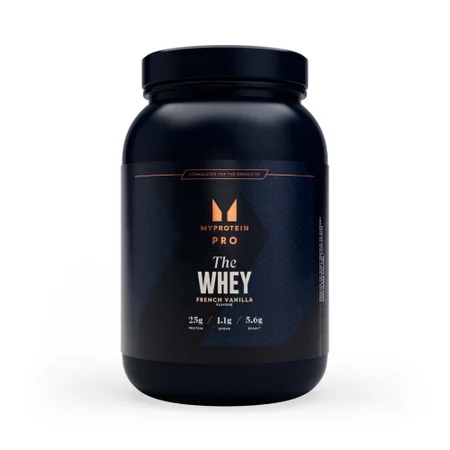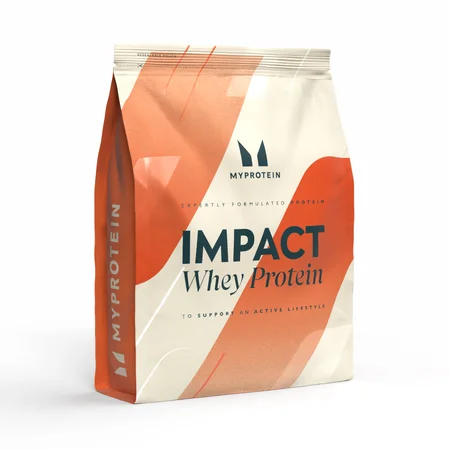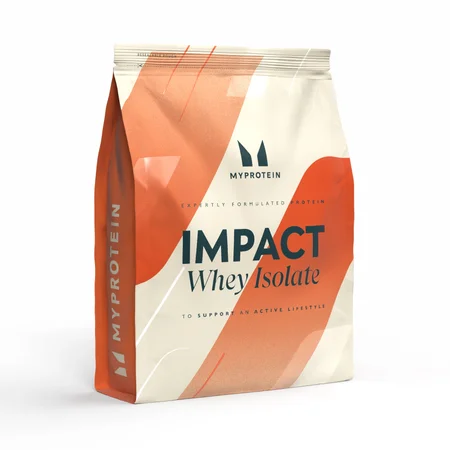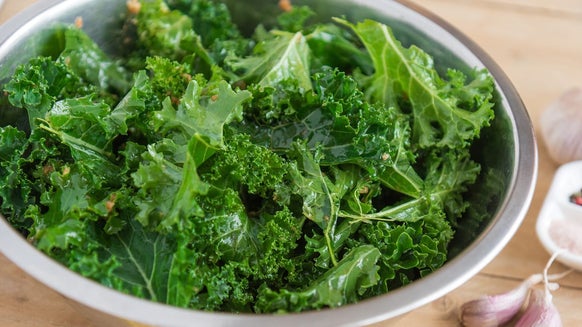ホエイプロテイン | コンセントレート?アイソレート?ホエイの作用、安全性、摂取量は?
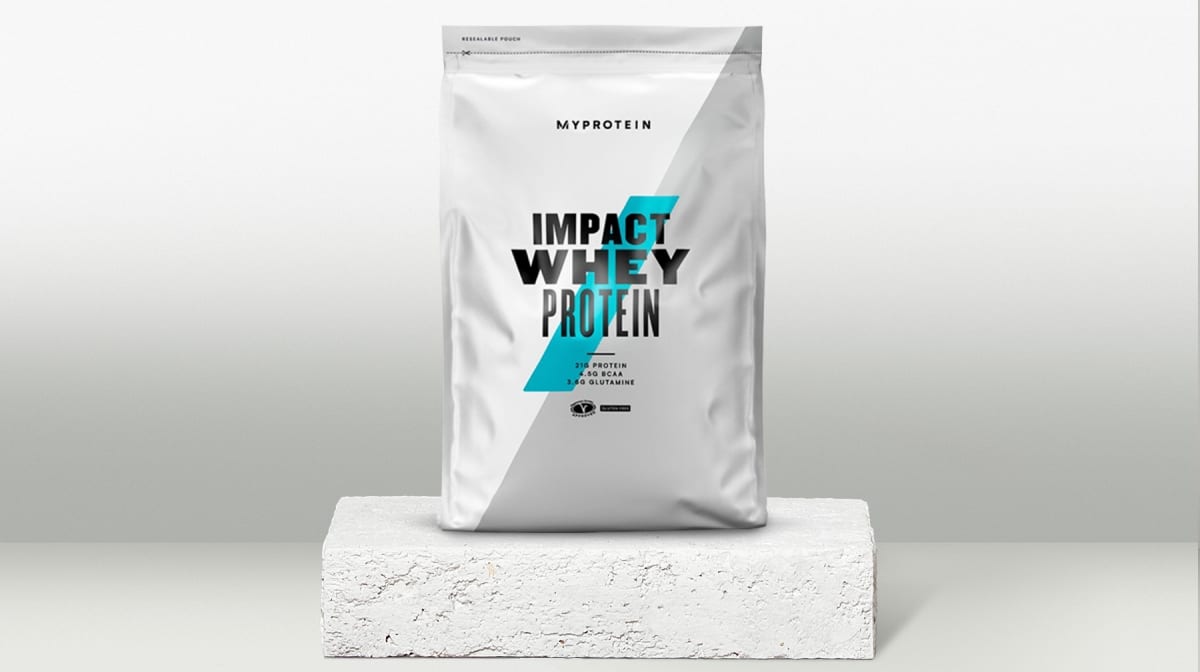
ホエイプロテイン(乳清タンパク質)はトレーニングをする全ての人達に高い評価を受けています。
ホエイプロテインは、様々な形態や種類のプロテイン商品の中で、王様といっても過言ではないでしょう。
筋肉のサポートが示された有効性によって、ホエイプロテインは非常に人気があり、最も一般的で広範なスポーツ栄養プロテインの1つとして認識されています(32-33)。
ジムに通う人やスポーツ選手が一般的に使用しており、膨大な研究論文の対象にもなっています。
この記事では、ジムトレーニングやスポーツや運動を行っている人達にホエイプロテインに関する研究結果と事実をお伝えして、ホエイプロテインがあなたにとって本当にベストな選択肢になるかを解説していきます。
ホエイプロテインとは何か?

乳清(ホエイ)は、かつてチーズと凝乳製造の廃棄副産物とみなされていました。生乳のタンパク質の約20%は乳清です。チーズと凝乳の生産中に、生乳は、レンネットエキスを添加する前に殺菌、乳酸菌接種およびインキュベーションを含む構造化されたプロセスを経ます。
レンネットエキス(新生子牛の胃から採取した酵素複合体)の添加は、乳の凝固を助け、乳固形分とホエイを分離します。
乳清濃縮物(ホエイ コンセントレート)と乳清分離物(ホエイ アイソレート)の違い

乳清濃縮物(ホエイ コンセンレート)
次に、新たに分離した混合物を濾過し、クエン酸で中和します。この液体ホエイの連続濾過によって、タンパク質の割合をタンパク質80%に濃縮します。さらに精密濾過を行い、タンパク質濃度を90%まで高めることができます(13)。次に液体乳清溶液を加温し、噴霧乾燥して乳清タンパク質粉末にします。これは、しばしばホエイ コンセントレートと記載されており、一定の脂肪と炭水化物(乳糖の形態)を含みます。
このタイプのタンパク質は29〜90%の総タンパク量を有しますが、70%および80%の濃度がスポーツ栄養サプリメントで最も一般的です(13-14)。マイプロテインの商品ではIMPACT ホエイ プロテインが乳清濃縮物のプロテインとなります。
乳清分離物(ホエイ アイソレート)
乳清タンパク質には、乳清に適用される異なる製造プロセスに基づいて様々なバリエーションもあります。これらは分離(すべてのラクトースとコレステロールと共に水分を除去し95%タンパク質濃度にする)と加水分解物(乳清を部分的に酵素とともに予め消化しペプチド分子のサイズを減少させ、吸収およびアミノ酸利用率を高める)として分類されます(47)。一般に乳清タンパク質加水分解物は、ホエイプロテインの最適な形態とされています(67)。マイプロテインの商品では、IMPACT ホエイ アイソレートが分離、加水分解 ホエイ プロテインが加水分解のプロテインとなります。
ホエイプロテインのメリット

ここで重要な点は、健康な人にホエイプロテインが与える影響を調べることです。
潜在的に影響を受ける各サブグループを詳細に調べることは難しいため、単純化しています。このように、利益の可能性があるにもかかわらず、特定の特別な集団に与えるすべての機能を掘り下げることはできません。
例えば、ホエイプロテインを、ビタミンDと併せて運動中に摂取すると、高齢者において脂肪のない筋肉、機能的な転帰および健康を高め加齢に関連した筋肉の減少を防ぐと考えられています(63)。
これは研究結果から明らかであり、大部分の研究では、運動やスポーツを定期的に行う人は、運動を行わない人よりも食事やサプリメントを通じてより多くのタンパク質を必要としているという考えを支持しています(13)。これは、正のネットタンパク質バランスに達するために必要なタンパク質摂取に行きつきます。
筋肉タンパク質合成としての機能
得られたまたは失われた筋肉の量は、タンパク質代謝を反映しています。簡単に言えば、タンパク質の追加またはタンパク質の損失は、筋肉タンパク質合成(MPS)と筋肉タンパク質分解のバランスで決定されます(54)。
タンパク質とアミノ酸の摂取(食事やサプリメントによる)は、MPSと正のネットタンパク質バランスを刺激し、一方、断絶はより高い分解速度と負のネットタンパク質バランスをもたらします(5)。健康で活動的な人々は、1日あたり1.5~2%のタンパク質代謝回転率があります(17)。
骨格筋タンパク質の分解も運動によって引き起こされます。つまり、正のタンパク質バランスを維持するためには、より多くのタンパク質を摂取する必要があります。
したがって、運動する人はより多くのタンパク質を摂取する必要があることを示しています。しかし、ホエイプロテインはその目的に役立つでしょうか?
綿密に計画された研究によると、ホエイプロテインの補給は、20g〜40gの範囲の摂取量で、各年齢のすべての人において筋肉タンパク質合成の刺激の最大化に有効であることが示されています(29、67、73)。
これは、生物学的にホエイプロテインがMPSの刺激を誘発することができることを示していますが、この機能は実際に私たちにも適用可能でしょうか?
ある研究では、条件を揃えた上で無作為に抽出した、9回の試験(被験者数合計192人)からデータを集めました(52)。この論文の著者たちは、ホエイタンパク質を単独で摂取した場合、あるいは、複数の素材で作られたスナックの一部として摂取した場合には、いずれも【筋力トレーニングと組み合わせた場合に】除脂肪体重が増加しやすくなる傾向があったことを発見しました。ここで見られた除脂肪体重の増加量は、炭水化物を摂取した場合、ホエイの入っていないタンパク質サプリメントを摂取した場合のいずれよりも多いものでした。また、ホエイタンパク質サプリメントを摂取した被験者たちは、上半身、下半身両方の筋力も増加していました。よって、この研究は、ホエイタンパク質を摂取する人にとっては、筋タンパク質合成(MPS)を活性化させることで得られる生物学的な利点が、実際の身体的な変化につながると思われることを示しています。
また、こうした結果は別の研究からも裏付けられています(11)。その研究では、ホエイタンパク質を摂取した場合、炭水化物を摂取した場合に比べて、除脂肪体重と筋力の増加量が200%多かったことが示されました。この研究は、興味深いことに、健康で、平均5年間の筋力トレーニング経験を持つ人々に対して実施されたものでした。つまり、ウェイトトレーニングを初めて行う人々(筋肉の増加量がより多くなりやすい)だけでなく、すでにトレーニングをしてきた人々に対しても、ホエイタンパク質摂取による恩恵があることを示しています。別の複数の研究では、ホエイタンパク質による筋肉量・筋力の増加促進能力を、他の形のタンパク質(例:カゼインや大豆タンパク質)と比べて評価することを目的とした調査が行われてきました。
そうした研究の1つでは、分離したホエイタンパク質の摂取、および、カゼインタンパク質の摂取を、いずれも体重1kgあたり1.5gの摂取量で行いましたが、どちらの場合も除脂肪体重と筋力の増加量は同じで、この点において、ホエイタンパク質とカゼインの結果は同様だと示されました(19)。しかしながら、他の論文の著者たちは、複数の研究結果を照らし合わせると、ホエイタンパク質によってもたらされた除脂肪体重の増加量は、カゼインおよび大豆のタンパク質源に比べて有意に大きかったことを示しています(56)。
運動パフォーマンスとしての作用

運動選手やスポーツ選手にとって重要なのは、ホエイプロテイン補給で明らかになった生理学的変化とともに、パフォーマンスに関連すると考えられる機能の報告もあることです。
筋トレ、運動パフォーマンスおよび運動後の使用に対する非特異的なプロテインサプリメントの利点は、22の試験を行った大規模なメタ分析研究で概説されています(16)。
680名の被験者のデータに基づいてまとめた結果は、脂肪のない筋肉の0.91kgの増加を示しただけでなく、1RMシングルレッグプレス強度で20.7kgの増加を示しました。今述べたように、これはホエイプロテインに特有ではありませんが、最も速く容易にタンパク質源を吸収するので、ホエイプロテインがこれらの機能を発揮する可能性が高いことは言うまでもありません。
2006年には、ホエイタンパク質とカゼインが、筋力増加の促進において同等の有効性を持つのか評価することを目指した研究の結果が発表されました(19)。この研究では、13人の男性ボディービルダーを10週間追跡調査しました。この被験者たちは、調査期間の間、食事に加えて体重1kgあたり1.5gのホエイタンパク質またはカゼインを摂取し、監督指導つきのトレーニングを受けました。その結果、ホエイタンパク質を追加摂取した人々のほうが、ベンチプレス、スクワット、ケーブルプルダウンにおいて、1回反復時(1RM)の最大負荷重量が、有意に大きく増加したことが見出されました。
また、この研究では、ホエイを摂取した人々は(カゼインを摂取した人々と比べて)除脂肪体重の増加量が5kg多くなり、脂肪重量の減少量も1.5k多くなっていました。こうした発見は、体重1kgあたり1.5gの単離ホエイタンパク質を摂取することが、激しいエクササイズ後の回復期間中におけるパフォーマンスの低下を最小限に抑える上で効果的であるという知見によって、さらに裏付けられています(18)。この結果は、レッグプレス、ニーエクステンション、ハムストリングカールという各エクササイズを強い負荷で行った場合に見られたものです。ボディービルディングで行われる典型的な筋力トレーニングは、確かに、ホエイタンパク質サプリメントの恩恵をはっきりと得やすいアクティビティなのかもしれません。
しかし、チームで行うスポーツでのパフォーマンスでも、ホエイタンパク質サプリメントの恩恵を得られることが示されています。 特に、アメリカの大学国体レベルでのバスケットボール選手たちの例では、除脂肪体重の増加量が1.4kg高まり、レッグプレスでの1RM最大負荷強度の増加量が4.9kg大きかったことが示されています。
しかしながら、個々のスポーツに特有の敏捷な走りにおいても、ホエイタンパク質摂取群は、炭水化物を摂取した対照群には見られなかったパフォーマンスの向上を示しました(72)。このことは、ホエイタンパク質摂取にともなって変化する、単独のパフォーマンス要素、身体の人体測定学的変化も、個々のスポーツに特有のパフォーマンス要素の向上につながるという可能性を示すのかもしれません。
ホエイプロテインの摂取量の目安

まず1日当たりの推奨量を設定し、タンパク質代謝や窒素損失(排尿や排泄による)の違いを考慮して、健康な成人におけるタンパク質合成と分解のバランスを維持するための提言をする必要があります。
この値は体重1kgあたり1日0.8gであり(35)、平均80kgの男性は以下のようになります。
0.8g×体重80kg = 1日あたり64g
この値は、19歳以上の健康な男性と女性の97.5%をカバーするとされています。しかし、運動をしてより多くのタンパク質を必要とする人では、除脂肪の発達と運動後の修復を可能にするために、タンパク質代謝に関する運動の費用がより高くなることも示されています(36、68)。実際に、タンパク質摂取のための主要な栄養ガイドラインは、肉体的に活動的な人々にとって、ポストトレーニングに1日あたり2g / kg以下が安全かつより効果的であることを示しています(13)。
このようなガイドラインは、食事中の全食品を介してタンパク質を得るためあらゆることを行わなければならならず、一方ホエイプロテインなどの供給源によるタンパク質補給は、タンパク質摂取を確実に達成できる効果的かつ効率的な方法であることを示しています(13)。
明確にするために、様々な形態の活動および運動について提案された推奨量を概説します。それぞれが、異なる量のタンパク質摂取を必要とする異なる身体的ストレッサーに該当する人の反応を促進するでしょう。
持久力が必要なアスリートのためのホエイ摂取量
一般的に、タンパク質の摂取量は、パフォーマンスの持続時間と強度に応じて、1g / kg〜1.6g / kgの範囲にすべきです(27、43、49、69)。
✓サイクリング
46%VO 2 maxで90分のサイクルを2回行う推奨量は、1日あたり1g / kgでした(21)。
✓ランニング
1日1.6g / kgの摂取量は、経験豊富なランナーのタンパク質(窒素バランス)要件を満たします(70)。
エリートランナーでは、この要件は、1日1.49g / kgに減少することが示されています(25)。
筋トレのためのホエイプロテイン摂取量
ウエイトリフティングやボディービルディングのような強度を伴う運動は、持久力運動よりも高いタンパク質を要求することは、ほとんどの人に明らかです。これは、初期段階のトレーニングの開始や、運動量が劇的に変化した場合に特に顕著です。
しかし、研究論文には、この集団についてより一般的に引用される特定の摂取量はありません。むしろ、一定のタンパク質摂取レベルを通常見ることができます。
除脂肪筋肉肥大を刺激するためには、1日当たり1.2-1.8g / kgが推奨です(1、16、38、42、69-70)。
十分なカロリーを得ている場合、同じ摂取量(1.2~1.8g)はトレーニングへの適応を促進します(57-58、65、71、75-76、80)。
ボディビルダーは、1日あたり1.12g / kg摂取することが明確に推奨されています(70)。
パワースポーツ選手(オリンピックのウェイトリフティングなど)は、1日あたり1.6-2g / kgの摂取が推奨されています(2、36、42、44、69)。
ボディビルダーは1日2〜3.1gの摂取が推奨されます(31)。十分な炭水化物と少ない脂肪摂取量で、除脂肪体重(LBM)を維持するための高摂取量が提案されているからです(30、50)。強度のある筋トレ(カロリー制限と並行)は、2g / kgのタンパク質摂取でも、負の窒素バランス(NNB)をもたらす可能性があります(12、15)。
断続的な運動やスポーツ選手のためのホエイ摂取量
断続的な活動を行うアスリートには、1日あたり1.4-1.7g / kgのタンパク質摂取が推奨されます(45)。これには、サッカーやバスケットボールなどのスポーツが含まれます。
ホエイプロテインの安全性

時折、高いホエイプロテイン摂取のマイナスの影響について主張があるにもかかわらず、そのような主張を支持する決定的な証拠は不足しています(32)。
実際、腎臓(40)、骨密度(39)、肝臓(53)および心臓血管系(33)の健康への影響に関する主張は、科学的に疑問があるか反証されています。
まとめ
ホエイプロテインは、運動後のタンパク質代謝のバランスを保つのに完璧なサプリメントです。ホエイプロテインは簡単に吸収され、筋肉タンパク質合成を促進し、除脂肪体重を形成するのに必要な全ての必須アミノ酸を提供する高品質タンパク源です。
また様々な味で手軽に利用でき、毎日の食事によるタンパク質摂取を補うために、簡単にタンパク質を取り入れることができます。最も人気がある唯一のサプリメントであるのも不思議ではありません。

ジェニファー・ブロウ(Jennifer Blow)はマイプロテインの編集者で、UKVRN*登録の栄養士としてキャリアを始めたばかり。栄養科学の学士号と栄養学の修士号を保有。現在は、スポーツサプリメントの健康・フィットネスへの使用について、科学的根拠に基づいた調査・研究を行なっています。*UKVRN:英国における栄養士の登記簿。登録には高い専門性と能力が必要。
また、エクササイズや健康的なライフスタイルのための栄養科学を専門としていることから、ヴォーグ、エル、グラツィアなどの有名オンライン雑誌に栄養士として登場しています。
これまで、NHS(イギリスの国民保健サービス)と協同で食生活への介入研究を行ったり、オメガ3脂肪酸サプリメントについてや、ファストフードが健康に及ぼす影響についての学術研究など、幅広い経験を積んできました。特に後者に関しては、毎年開催されるNutrition Society Conferenceで発表も行いました。さらに、プロ養成のために開催されるイベントにも多く出席し、常に高い専門性を維持しようと努めています。
ジェニファーについて詳細は、こちらをご覧ください。
プライベートでは、ヒルウォーキングとサイクリングの愛好家。SNSを通じて、我慢しなくても健康的な食生活が送れることを広めています。
- merican Dietetic Association, Dietitians of Canada, American College of Sports Medicine, Rodriguez, N.R., Di Marco, N.M. & Langley S. (2009). American college of sports medicine position stand: Nutrition and athletic performance. Med Sci Sports Exerc. 41, 3, 709–31
- Antonio J, Stout JR: Sports Supplements. Philadelphia, PA , Lippincott Williams & Wilkins; 2001.
- Baty, J.J., Hwang, H., Ding, Z., Bernard, J.R., Wang, B., Kwon, B., et al. (2007). The effect of a carbohydrate and protein supplement on resistance exercise performance, hormonal response, and muscle damage. Journal of Strength and Conditioning Research, 21, 321–329.
- Biolo G, Maggi SP, Williams BD, Tipton KD, Wolfe RR: Increased rates of muscle protein turnover and amino acid transport after resistance exercise in humans. Am J Physiol 1995, 268(3 Pt 1):E514-20.
- Biolo G, Tipton KD, Klein S, Wolfe RR (1997) An abundant supply of amino acids enhances the metabolic effect of exercise on muscle protein. Am J Physiol 273(1 Pt 1):E122–E129
- Bird, S.P., Tarpenning, K.M. and Marino, F.E. (2006). Liquid carbohydrate/essential amino acid ingestion during a short-term bout of resistance exercise suppresses myofibrillar protein degradation. Metabolism, 55, 570–577.
- Boirie Y, Dangin M, Gachon P, Vasson MP, Maubois JL, Beaufrere B: Slow and fast dietary proteins differently modulate postprandial protein accretion. Proc Natl Acad Sci USA 1997, 94:14930-14935
- Borsheim E, Tipton KD, Wolf SE, and Wolfe RR. Essential amino acids and muscle protein recovery from resistance exercise. Am J Physiol Endocrinol Metab 283: E648–E657, 2002.
- Bounous G, Batist G, Gold P: Immunoenhancing property of dietary whey protein in mice: role of glutathione. Clin Invest Med 1989, 12(3):154-161.
- Bounous G, Kongshavn PA, Gold P: The immunoenhancing property of dietary whey protein concentrate. Clin Invest Med 1988, 11(4):271-278.
- Burke DG, Chilibeck PD, Davidson KS, Candow DG, Farthing J, and Smith- Palmer T. The effect of whey protein supplementation with and without creatine monohydrate combined with resistance training on lean tissue mass and muscle strength. Int J Sport Nutr Exerc Metab 11: 349–364, 2001.
- Butterfield, G.E. (1987). Whole-body protein utilization in humans. Medicine and Science in Sports and Exercise, 19, S157–S165.
- Campbell, B., Kreider, R.B., Ziegenfuss, T., La Bounty, P., Roberts, M., Burke, D., Landis, J., Lopez, H. and Antonio, J., 2007. Journal of the International Society of Sports Nutrition. Journal of the International Society of Sports Nutrition, 4(8), p.8.
- Carunchia Whetstine ME, Croissant AE, Drake MA: Characterization of dried whey protein concentrate and isolate flavor. J Dairy Sci 2005, 88:3826-3839.
- Celejowa, I. and Homa, M. (1970). Food intake, nitrogen and energy balance in Polish weight lifters, during a training camp. Nutrition and Metabolism, 12, 259–274.
- Cermak NM, Res PT, de Groot LC, Saris WH, and van Loon LJ. Protein supplementation augments the adaptive response of skeletal muscle to resistancetype exercise training: A meta-analysis. Am J Clin Nutr 96: 1454–1464, 2012.
- Churchward-Venne, T.A., Murphy, C.H., Longland, T.M. and Phillips, S.M., 2013. Role of protein and amino acids in promoting lean mass accretion with resistance exercise and attenuating lean mass loss during energy deficit in humans. Amino Acids, 45(2), pp.231-240
- Cooke, M.B., Rybalka, E., Stathis, C.G., Cribb, P.J. and Hayes, A., 2010. Whey protein isolate attenuates strength decline after eccentrically-induced muscle damage in healthy individuals. J Int Soc Sports Nutr, 7(1), p.30.
- Cribb PJ, Williams AD, Carey MF, and Hayes A. The effect of whey isolate and resistance training on strength, body composition, and plasma glutamine. Int J Sport Nutr Exerc Metab 16: 494–509, 2006.
- Dangin M, Boirie Y, Guillet C, Beaufrere B: Influence of the protein digestion rate on protein turnover in young and elderly subjects. J Nutr 2002, 132:3228S-33S.
- el-Khoury AE, Forslund A, Olsson R, Branth S, Sjodin A, Andersson A, Atkinson A, Selvaraj A, Hambraeus L, and Young VR. Moderate exercise at energy balance does not affect 24-h leucine oxidation or nitrogen retention in healthy men. Am J Physiol 273: E394–E407, 1997.
- Esmarck, B., Andersen, J.L., Olsen, S., Richter, E.A., Mizuno, M. and Kjaer, M. (2001). Timing of postexercise protein intake is important for muscle hypertrophy with resistance training in elderly humans. Journal of physiology, 535, 301–3.
- Etzel MR: Manufacture and use of dairy protein fractions. J Nutr 2004, 134:996S-1002S.
- Flakoll PJ, Judy T, Flinn K, Carr C, Flinn S: Postexercise protein supplementation improves health and muscle soreness during basic military training in Marine recruits. J Appl Physiol2004, 96(3):951-956.
- Friedman JE and Lemon PW. Effect of chronic endurance exercise on retention of dietary protein. Int J Sports Med 10: 118– 123, 1989.
- Fujita, S., Dreyer, H.C., Drummond, M.J., Glynn, E.L., Volpi, E. and Rasmussen, BB. (2009). Essential amino acid and carbohydrate ingestion before resistance exercise does not enhance postexercise muscle protein synthesis. Journal of Applied Physiology2009, 106:1730–1739.
- Gaine PC, Pikosky MA, Martin WF, Bolster DR, Maresh CM, Rodriguez NR: Level of dietary protein impacts whole body protein turnover in trained males at rest. Metabolism 2006, 55(4):501-507.
- Ha E, Zemel MB: Functional properties of whey, whey components, and essential amino acids: mechanisms underlying health benefits for active people (review). J Nutr Biochem 2003, 14:251-258.
- Hayes A and Cribb PJ. Effect of whey protein isolate on strength, body composition and muscle hypertrophy during resistance training. Curr Opin Clin Nutr Metab Care 11: 40–44, 2008.
- Helms, E. R., Aragon, A. A., & Fitschen, P. J. (2014). Evidence-based recommendations for natural bodybuilding contest preparation: nutrition and supplementation. J Int Soc Sports Nutr, 11(1), 20.
- Helms, E.R., Zinn, C., Rowlands, D.S. and Brown, S.R., 2013. A systematic review of dietary protein during caloric restriction in resistance trained lean athletes: a case for higher intakes. International Journal of Sports Nutrition Exerc Metab, 24, pp.127-38.
- Hoffman, J.R. and Falvo, M.J., 2004. Protein-Which is best. Journal of Sports Science and Medicine, 3(3), pp.118-130.
- Hu, F.B., Stampfer, M.J., Manson, J.E., Rimm, E., Colditz, G.A., Speizer, F.E., Hennekens, C.H. and Willett, W.C. (1999) Dietary protein and risk of ischemic heart disease in women. AmericanJournal of Clinical Nutrition 70, 221-227.
- Hulmi, J.J., Lockwood, C.M. and Stout, J.R., 2010. Effect of protein/essential amino acids and resistance training on skeletal muscle hypertrophy: A case for whey protein. Nutrition & metabolism, 7(1), p.1.
- Institute of Medicine of the National Academies: Dietary reference intakes for energy, carbohydrate, fiber, fat, fatty acids, cholesterol, protein, and amino acids (macronutrients). Washington, DC , National Academies Press; 2002.
- Joint Position Statement: nutrition and athletic performance. American College of Sports Medicine, American Dietetic Association, and Dietitians of Canada. Med Sci Sports Exerc 2000, 32(12):2130-2145.
- Katsanos CS, Chinkes DL, Paddon-Jones D, Zhang XJ, Aarsland A, Wolfe RR: Whey protein ingestion in elderly persons results in greater muscle protein accrual than ingestion of its constituent essential amino acid content. Nutr Res 2008, 28:651-658.
- Kerksick, C., Harvey, T., Stout, J., Campbell, B., Wilborn, C., Kreider, R., Kalman, D., Ziegenfuss, T., Lopez, H., Landis, J. and Ivy, J.L., 2008. Journal of the International Society of Sports Nutrition. Journal of the International Society of Sports Nutrition, 5, 17.
- Kerstetter JE, O’Brien KO, Caseria DM, Wall DE, Insogna KL:The impact of dietary protein on calcium absorption and kinetic measures of bone turnover in women. J Clin Endocrinol Metab2005, 90(1):26-31.
- Knight EL, Stampfer MJ, Hankinson SE, Spiegelman D, Curhan GC: The impact of protein intake on renal function decline in women with normal renal function or mild renal insufficiency. Ann Intern Med 2003, 138(6):460-7
- Krissansen GW: Emerging health properties of whey proteins and their clinical implications. J Am Coll Nutr 2007, 26:713S-23S.
- Lemon PW, Tarnopolsky MA, MacDougall JD, and Atkinson SA. Protein requirements and muscle mass/strength changes during intensive training in novice bodybuilders. J Appl Physiol (1985) 73: 767 775, 1992.
- Lemon PW: Beyond the zone: protein needs of active individuals. J Am Coll Nutr 2000, 19(5 Suppl):513S 521S
- Lemon PW: Protein and amino acid needs of the strength athlete. Int J Sport Nutr 1991, 1(2):127-145.
- Lemon PW: Protein requirements of soccer. J Sports Sci 1994, 12 Spec No:S17-22.
- Levenhagen, D.K., Gresham, J.D., Carlson, M.G., Maron, D.J., Borel, M.J. and Flakoll, P.J. (2001). Postexercise nutrient intake timing in humans is critical to recovery of leg glucose and protein homeostasis. American Journal of Physiology: Endocrinology and Metabolism, 280, E982–E993
- Manninen AH: Protein hydrolysates in sports nutrition. Nutr Metab (Lond) 2009, 6:38.
- McLain, T.A., Escobar, K.A. and Kerksick, C.M., 2015. Protein Applications in Sports Nutrition—Part I: Requirements, Quality, Source, and Optimal Dose. Strength & Conditioning Journal, 37(2), pp.61-71.
- Meredith CN, Zackin MJ, Frontera WR, Evans WJ: Dietary protein requirements and body protein metabolism in endurancetrained men. J Appl Physiol 1989, 66(6):2850-2856.
- Mettler, S., Mitchell, N. and Tipton, K.D. (2010). Increased protein intake reduces lean body mass loss during weight loss in athletes. Medicine and Science in Sports and Exercise, 42, 326–337.
- Miller SL, Tipton KD, Chinkes DL,Wolf SE, and Wolfe RR. Independent and combined effects of amino acids and glucose after resistance exercise. Med Sci Sports Exerc 35: 449–455, 2003.
- Naclerio, F. and Larumbe-Zabala, E., 2016. Effects of Whey Protein Alone or as Part of a Multi ingredient Formulation on Strength, Fat-Free Mass, or Lean Body Mass in Resistance-Trained Individuals: A Meta-analysis. Sports Medicine, 46(1), pp.125-137.
- Navder, K.P. and Lieber, C.S. (2003b) Nutrition and alcoholism. In: Nutritional Aspects and Clinical Management of Chronic Disorders and Diseases. Ed: Bronner, F. Boca Raton, FL: CRC Press. 307- 320
- Phillips SM, Hartman JW, Wilkinson SB (2005) Dietary protein to support anabolism with resistance exercise in young men. J Am Coll Nutr 24(2):134S–139S
- Phillips SM, Parise G, Roy BD, Tipton KD, Wolfe RR, Tamopolsky MA: Resistance-training-induced adaptations in skeletal muscle protein turnover in the fed state. Can J Physiol Pharmacol 2002, 80(11):1045-1053.
- Phillips SM, Tang JE, and Moore DR. The role of milk- and soy-based protein in support of muscle protein synthesis and muscle protein accretion in young and elderly persons. J Am Coll Nutr 28: 343– 354, 2009.
- Phillips SM. (2004). Protein requirements and supplementation in strength sports. Nutrition, 20, 689-695.
- Phillips, S.M. and Van Loon, L.J. (2011). Dietary protein for athletes: from requirements to optimum adaptation. Journal of Sports Science, 29 (Suppl 1), S29–S38.
- Rasmussen BB, Tipton KD, Miller SL, Wolf SE, and Wolfe RR. An oral essential amino acid-carbohydrate supplement enhances muscle protein anabolism after resistance exercise. J Appl Physiol (1985) 88: 386–392, 2000.
- Rennie MJ, Bohe J, Smith K, Wackerhage H, Greenhaff P: Branchedchain amino acids as fuels and anabolic signals in human muscle. J Nutr 2006, 136(1 Suppl):264S-8S.
- Rieu I, Balage M, Sornet C, Debras E, Ripes S, Rochon-Bonhomme C, Pouyet C, Grizard J, Dardevet D: Increased availability of leucine with leucine-rich whey proteins improves postprandial muscle protein synthesis in aging rats. Nutrition 2007, 23:323-331
- Rodriguez NR, Vislocky LM, Gaine PC: Dietary protein, endurance exercise, and human skeletal-muscle protein turnover. Curr Opin Clin Nutr Metab Care 2007, 10(1):40-45.
- Rondanelli, M., Klersy, C., Terracol, G., Talluri, J., Maugeri, R., Guido, D., Faliva, M.A., Solerte, B.S., Fioravanti, M., Lukaski, H. and Perna, S., 2016. Whey protein, amino acids, and vitamin D supplementation with physical activity increases fat-free mass and strength, functionality, and quality of life and decreases inflammation in sarcopenic elderly. The American journal of clinical nutrition, 103(3), pp.830-840.
- Schaafsma, G., 2000. The protein digestibility–corrected amino acid score. The Journal of nutrition, 130(7), pp.1865S-1867S.
- Slater, G. and Phillips, SM. (2011). Nutrition guidelines for strength sports: sprinting, weightlifting, throwing events, and bodybuilding. Journal of Sports Science, 29, S67–S77.
- Smith K, Reynolds N, Downie S, Patel A, Rennie MJ: Effects of flooding amino acids on incorporation of labeled amino acids into human muscle protein. Am J Physiol 1998, 275:E73-8.
- Tang JE, Moore DR, Kujbida GW, Tarnopolsky MA, and Phillips SM. Ingestion of whey hydrolysate, casein, or soy protein isolate: Effects on mixed muscle protein synthesis at rest and following resistance exercise in young men. J Appl Physiol (1985) 107: 987–992, 2009.
- Tarnopolsky M: Protein requirements for endurance athletes. Nutrition 2004, 20(7-8):662-668.
- Tarnopolsky MA, Atkinson SA, MacDougall JD, Chesley A, Phillips S, and Schwarcz HP. Evaluation of protein requirements for trained strength athletes. J Appl Physiol (1985) 73: 1986–1995, 1992.
- Tarnopolsky MA, MacDougall JD, and Atkinson SA. Influence of protein intake and training status on nitrogen balance and lean body mass. J Appl Physiol 64: 187–193, 1988.
- Tarnopolsky, M.A. (2008). Building muscle: nutrition to maximize bulk and strength adaptations to resistance exercise training. European Journal of Sport Science, 8, 67–76
- Taylor IV, L.W., Wilborn, C., Roberts, M.D., White, A. and Dugan, K., 2015. Eight weeks of pre-and post exercise whey protein supplementation increases lean body mass and improves performance in Division III collegiate female basketball players. Applied Physiology, Nutrition, and Metabolism, (ja).
- Tipton KD, Elliott TA, Cree MG, Wolf SE, Sanford AP, and Wolfe RR. Ingestion of casein and whey proteins result in muscle anabolism after resistance exercise. Med Sci Sports Exerc 36: 2073–2081, 2004.
- Tipton KD, Ferrando AA, Phillips SM, Doyle D Jr, and Wolfe RR. Postexercise net protein synthesis in human muscle from orally administered amino acids. Am J Physiol 276: E628–E634, 1999
- Tipton, K.D. (2008). Protein for adaptations to exercise training. European Journal of Sports Science, 8, 107–118.
- Tipton, K.D. and Wolfe, R.R. (2004). Protein and amino acids for athletes. Journal of Sports Science, 22, 65-79.
- Tipton, K.D., Elliott, T.A., Cree, M.G., Aarsland, A.A., Sanford, A.P., Wolfe, R.R. (2007). Stimulation of net muscle protein synthesis by whey protein ingestion before and after exercise. American Journal of Physiology: Endocrinology and Metabolism, 292, E71–E76.
- Tipton, K.D., Rasmussen, B.B., Miller, S.L., Wolf, S.E., Owens-Stovall, S.K., Petrini, B.E. et al. (2001). Timing of amino acid-carbohydrate ingestion alters anabolic response of muscle to resistance exercise. American Journal of Physiology: Endocrinology and Metabolism, 281, E197–E206.
- Wells, G.D., 2009. The Post-Workout Protein Puzzle: Which Protein Packs the Most Punch?. Strength & Conditioning Journal, 31(1), pp.27-30.
- Wilson, J. and Wilson, G.J. (2006). Contemporary issues in protein requirements and consumption for resistance trained athletes. Journal of the International Society of Sports Nutrition, 3, 7–27.
- Yang Y, Jemiolo B, Trappe S: Proteolytic mRNA expression in response to acute resistance exercise in human single skeletal muscle fibers. J Appl Physiol 2006, 101(5):1442-1450.
